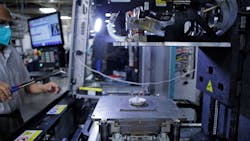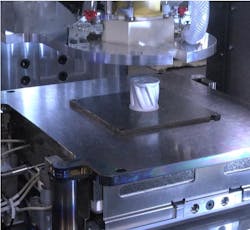Liquid Metal 3D Printing Makes Its Debut
Not unlike having a backup server or installing redundancy in critical systems, the on-demand nature of 3D printing—also known as additive manufacturing (AM)—can help end-users navigate increasingly common supply chain disruptions caused by trade shake-ups, unexpected supplier limitations, and global pandemics. In addition to allowing operators to rapidly produce spare parts that may no longer be available from the original manufacturers, AM continues to show promise in mass production, with some manufacturers using it to ramp up output of personal protective equipment (PPE) in the early days of the COVID-19 pandemic.
However, AM is not without its challenges. This is particularly true with powder bed fusion (PBF), a process commonly employed in commercial and industrial 3D printing applications where a laser or electron beam is used to melt and fuse powdered materials together. For instance, objects printed with PBF may exhibit weak structural properties compared to other manufacturing processes and may require post-processing, adding labor and costs.
That said, recent innovations in a production methodology called liquid metal jet printing (LMJP) may help to surmount these issues.
Xerox’s new ElemX 3D liquid metal printer is one of the first products on the market to employ the technology. Rather than powder inputs, The ElemX uses molten solid metal provided by standard commodity aluminum wire fed into the machine. According to Xerox, this new method can decrease total cost of ownership, increase cycle times, and improve safety, all while providing production-grade parts.
In an in-house use case, reported by Forbes, Xerox was able to deploy its own technology to great success. When a bracket for a digital press required replacement, the ElemX was able to reproduce the part within four hours with an estimated 21% reduction in costs and 43% decrease in CO2 emissions compared to traditional metal casting. In a second trial, in which it was benchmarked against a PBF AM system, the ElemX produced the same bracket at an estimated 38% cost savings and a 40% reduction in cycle time.
Moreover, independent research from the State University of New York and Concordia University asserts that LMJP may be up to 10 times faster and one-tenth the cost of prevailing AM methods. In addition, this research notes that LMJP may lead to denser metal parts with finer microstructures, resulting in a 30% or greater increase in overall tensile strength.
Xerox foresees the deployment of the ElemX beginning in defense, aerospace, heavy equipment, and oil and gas, due to these industries’ complex supply chains and essential nature.
Currently, ElemX has seen its first deployment at the U.S. Naval Postgraduate School (NPS) in Monterrey, Calif., where it will be used in military research efforts.
“From the age of sail to the nuclear era, sailors have been fixing things at sea so they can complete the mission,” said NPS President Ann Rondeau. “This partnership is about the strategic ability of the navy to have sailors on ships with the capability—through creativity and technology—to advance their operations at sea.”
While NPS envisions ElemX being deployed in a back-up capacity for spare parts and batches of one, Xerox’s long-term goal is for the ElemX to be used in mass production.
About the Author
David Miller
Former Senior Technical Writer

Leaders relevant to this article:

